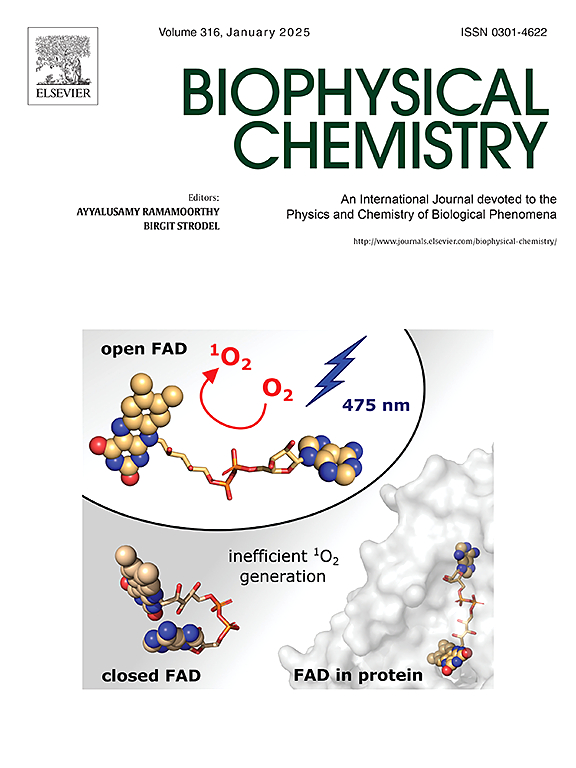Effect of ergosterol or cholesterol on the morphology and dynamics of the POPC/sphingomyelin bilayer
IF 2.2
3区 生物学
Q2 BIOCHEMISTRY & MOLECULAR BIOLOGY
引用次数: 0
Abstract
Phase segregation and domain formation in cell membranes and model lipid bilayers have become a relevant topic in the last decades due to their role in important cell functions such as signaling and molecule-membrane interactions. To date, the most accepted explanation for the formation of these domains in mammalian cells is that cholesterol-enriched sphingomyelin patches of membrane form because of the preferential interaction between them. However, detailed information on molecular interactions within cholesterol-containing bilayers and their comparison with other sterol-containing bilayers, such as those containing ergosterol, is needed to understand the role these molecules have. Recent experimental findings have shown sterol-dependent differences in the morphology of supported lipid bilayers, but the molecular basis for these differences remains unclear. This work provides a molecular explanation for these differences using atomistic Molecular Dynamics simulations of lipid bilayers composed of 1-palmitoyl-2-oleoyl-glycero-3-phosphocholine (POPC) and N-palmitoyl-D-erythro-sphingosylphosphorylcholine (PSM) with 20 mol% of cholesterol or ergosterol. Atomic force microscopy was used to validate the simulation. The simulation ran for 11 μs and revealed that both sterols affect the morphology of the membrane. Key findings include: ergosterol induces greater order in PSM domains compared to cholesterol, lipid diffusion constants are lower in ergosterol-containing membranes, sterol flip-flop rates are significantly reduced in ergosterol-containing membranes and ergosterol leads to greater PSM-sterol enrichment. These molecular-level differences provide insight into the experimentally observed variations in domain formation and membrane properties between cholesterol and ergosterol-containing bilayers. Our findings contribute to the understanding of sterol-specific effects on membrane organization and dynamics, with potential implications for cellular processes and drug interactions in different organisms.
Statement of significance
This study advances our understanding of how different sterols influence membrane properties through molecular dynamics simulations of three-component lipid membranes. Specifically, we investigate the effects of two major sterols: ergosterol, predominantly found in plants and fungi, and cholesterol, characteristic of mammalian cells. While extensive research has elucidated cholesterol's impact on lipid bilayers, studies on ergosterol's effects are comparatively limited. Our work provides a comprehensive comparison of these sterols, highlighting their similarities and differences. These insights not only enhance our knowledge of cell membrane structure and function, but also contribute to our understanding of selective drug permeability across membranes. This research has potential implications for both fundamental cell biology and pharmaceutical applications.

麦角甾醇或胆固醇对POPC/鞘磷脂双分子层形态和动力学的影响
在过去的几十年里,细胞膜和模型脂质双层中的相分离和结构域形成已经成为一个相关的话题,因为它们在重要的细胞功能中起着重要的作用,如信号传导和分子-膜相互作用。迄今为止,对这些结构域在哺乳动物细胞中形成的最被接受的解释是,由于它们之间的优先相互作用,膜上富含胆固醇的鞘磷脂斑块形成。然而,要了解这些分子的作用,需要了解含胆固醇双分子层内部分子相互作用的详细信息,以及它们与其他含胆固醇双分子层(如含麦角甾醇的双分子层)的比较。最近的实验发现显示了甾醇依赖性的脂质双分子层形态差异,但这些差异的分子基础尚不清楚。本研究利用原子分子动力学模拟了由1-棕榈酰-2-油酰-甘油-3-磷酸胆碱(POPC)和n -棕榈酰- d -红-鞘酰基磷酸胆碱(PSM)与20 mol%的胆固醇或麦角甾醇组成的脂质双分子层,为这些差异提供了分子解释。采用原子力显微镜对模拟结果进行验证。模拟时间为11 μs,结果表明这两种甾醇都会影响膜的形态。主要发现包括:与胆固醇相比,麦角甾醇诱导PSM结构域的有序性更高,含麦角甾醇膜中的脂质扩散常数更低,含麦角甾醇膜中的甾醇转换率显著降低,麦角甾醇导致更大的PSM-甾醇富集。这些分子水平上的差异提供了对实验观察到的胆固醇和麦角甾醇双分子层之间结构域形成和膜性质的变化的见解。我们的发现有助于理解甾醇对膜组织和动力学的特异性作用,对不同生物体的细胞过程和药物相互作用具有潜在的影响。本研究通过对三组分脂质膜的分子动力学模拟,加深了我们对不同甾醇如何影响膜性质的理解。具体来说,我们研究了两种主要甾醇的作用:麦角甾醇,主要存在于植物和真菌中,以及胆固醇,哺乳动物细胞的特征。虽然广泛的研究已经阐明了胆固醇对脂质双分子层的影响,但对麦角甾醇作用的研究相对有限。我们的工作提供了这些固醇的全面比较,突出他们的异同。这些发现不仅增强了我们对细胞膜结构和功能的认识,而且有助于我们对药物选择性跨膜渗透的理解。这项研究对基础细胞生物学和药物应用都有潜在的意义。
本文章由计算机程序翻译,如有差异,请以英文原文为准。
求助全文
约1分钟内获得全文
求助全文
来源期刊

Biophysical chemistry
生物-生化与分子生物学
CiteScore
6.10
自引率
10.50%
发文量
121
审稿时长
20 days
期刊介绍:
Biophysical Chemistry publishes original work and reviews in the areas of chemistry and physics directly impacting biological phenomena. Quantitative analysis of the properties of biological macromolecules, biologically active molecules, macromolecular assemblies and cell components in terms of kinetics, thermodynamics, spatio-temporal organization, NMR and X-ray structural biology, as well as single-molecule detection represent a major focus of the journal. Theoretical and computational treatments of biomacromolecular systems, macromolecular interactions, regulatory control and systems biology are also of interest to the journal.
 求助内容:
求助内容: 应助结果提醒方式:
应助结果提醒方式:


